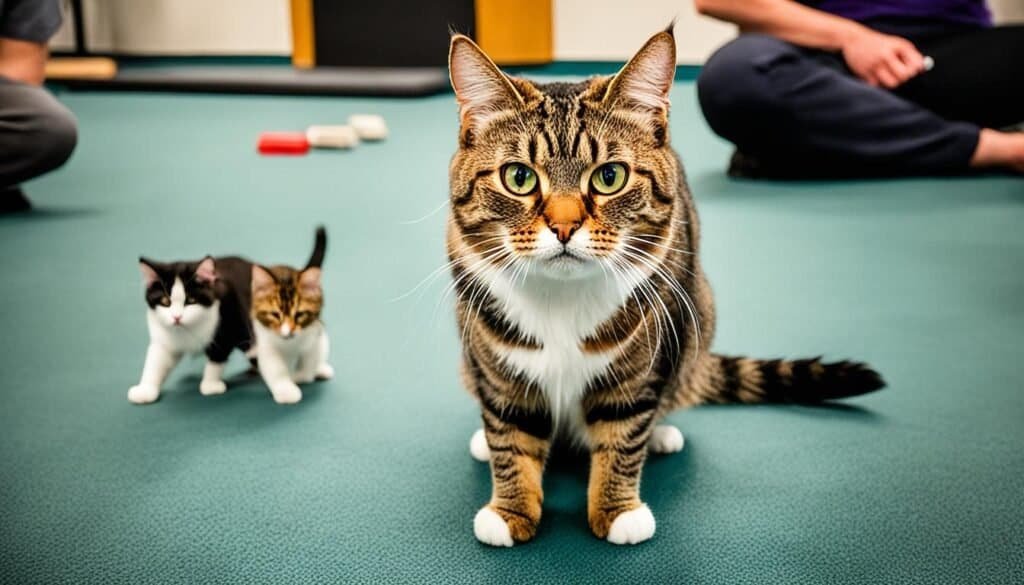Cat training challenges can be a rewarding experience, but it can also come with its fair share of challenges. Understanding cat behavior issues and feline training difficulties is crucial for successful training outcomes. In this article, we will delve into the common obstacles faced when training cats, offering insights and practical tips to help you overcome them effectively.
Key Takeaways
- Cat training involves addressing various behavior issues and feline training difficulties.
- Understanding cat behavior patterns is essential before implementing training strategies.
- A positive training environment with the use of treats and positive reinforcement techniques is crucial.
- Basic training techniques lay the foundation for successful cat behavior modification.
- Addressing specific behavior issues requires practical solutions and troubleshooting tips.
Understanding Feline Behavior
Before delving into training strategies, it is essential to have a comprehensive understanding of feline behavior. Cats, like humans, have distinct personalities and behaviors that can pose challenges during training. This section will explore some of the common behavior issues exhibited by cats and how they can impact the training process.
One of the most prevalent behavior issues is scratching furniture. Cats naturally scratch to maintain their claws and mark their territory. However, this behavior becomes problematic when cats target valuable or delicate furniture pieces. Understanding why cats scratch and providing appropriate alternatives, such as scratching posts, can help redirect this behavior during training.
Aggression is another behavior issue that many cat owners encounter. Whether it’s directed towards other pets, humans, or even objects, aggression can hinder training progress. Identifying the triggers of aggression and implementing behavior modification techniques can help address this issue effectively.
Litter box problems are yet another common behavior issue that can hinder successful training. Cats may refuse to use the litter box due to discomfort, stress, or other underlying issues. Implementing litter box hygiene practices and providing a suitable environment can encourage proper litter box usage.
Lastly, cats may exhibit various other behavior issues, such as excessive meowing, jumping on counters, or hiding. Each of these behaviors has its own underlying causes, and understanding them is crucial for effective training. By addressing these behavior issues, cat owners can overcome training difficulties and create a harmonious environment for both themselves and their feline companions.
Creating a Positive Training Environment
When it comes to training stubborn cats, creating a positive environment is crucial for success. By setting the right atmosphere, you can engage your feline companion more effectively and encourage desirable behaviors. In this section, we will discuss effective cat behavior solutions and provide insights into how you can create a conducive training environment.
Treats and Toys: Using treats and toys can be a powerful motivator for cats during training sessions. Positive reinforcement with treats helps reinforce desired behaviors, while interactive toys can keep them stimulated and focused. Incorporating these elements into your training routine can help keep your cat engaged and eager to learn.
Positive Reinforcement: Cats respond well to positive reinforcement techniques. When your cat exhibits a desired behavior, immediately reward them with praise, treats, or playtime. This positive association helps them understand what behaviors are desired and reinforces the training process. Remember, consistency is key when using positive reinforcement.
Repetition and Patience: Training stubborn cats requires repetition and patience. Cats may take some time to learn and adapt to new behaviors, so it’s important to be patient and consistent. Consistently practice the desired behavior and reinforce it with rewards. With time and consistency, your cat will begin to understand and respond to your training efforts.
To create a positive training environment, remember to keep sessions short and frequent. Cats have shorter attention spans, so shorter training sessions spread throughout the day are more effective than long sessions. Also, choose a quiet and distraction-free space for training to minimize external stimuli that may divert your cat’s attention.
By implementing these effective cat behavior solutions and creating a positive training environment, you can overcome the challenges of training stubborn cats and achieve successful results. In the next section, we will dive into laying the foundation with basic training techniques.
Laying the Foundation: Basic Training Techniques
When it comes to training cats, basic training techniques play a crucial role in shaping their behavior. By establishing a solid foundation, you can address obedience training obstacles and achieve effective cat behavior solutions. In this section, we will explore some essential techniques that every cat owner should know.
Clicker Training
Clicker training is a popular method that uses positive reinforcement to shape a cat’s behavior. By associating the sound of a clicker with a reward, you can communicate desired behaviors to your cat. Start by clicking the clicker and immediately following it with a treat. Repeat this process several times to familiarize your cat with the clicker’s sound and the reward it signifies. Once your cat has made this association, you can use the clicker to mark and reinforce desired behaviors during training sessions.
Targeting
Targeting is another effective training technique that can help overcome obedience training obstacles in cats. This method involves teaching your cat to touch a specific object, such as a stick or your hand, with their nose or paw. Begin by presenting the target object to your cat and rewarding them when they interact with it. Gradually move the target object to different locations and reward your cat each time they successfully touch it. Targeting can be particularly useful for teaching cats to come when called or directing them to perform specific actions.
Leash Training
Leash training is beneficial for cats who enjoy exploring the great outdoors. While it may seem unconventional, many cats can learn to walk on a leash with proper training. Start by introducing your cat to a harness and leash indoors, allowing them to become accustomed to wearing the gear. Once they are comfortable, attach the leash and take them for short walks around your home. Gradually increase the length and frequency of the walks, allowing your cat to explore and experience new environments while under your supervision. Leash training not only provides mental and physical stimulation for your cat but also enables you to have better control when venturing outside.
By utilizing these basic training techniques, you can lay a solid foundation for your cat’s behavior modification. Clicker training, targeting, and leash training are effective methods to overcome cat obedience training obstacles and achieve long-term behavior solutions.
Addressing Specific Behavior Issues
In this section, we will tackle common behavior issues that cat owners often face during training. Cats can exhibit various problematic behaviors, such as excessive meowing, clawing at curtains, or jumping on counters. These behaviors can disrupt the training process and frustrate cat owners.
To help you cope with these cat training problems, we have compiled practical solutions and troubleshooting tips. By implementing these strategies, you’ll be able to address these behavior issues effectively and make progress in your training sessions.
Excessive Meowing
Excessive meowing is a behavior that can be a source of annoyance for both you and your cat. To reduce excessive meowing:
- Ensure your cat’s basic needs, such as food, water, and a clean litter box, are met.
- Provide mental and physical stimulation through interactive toys and regular playtime.
- Consider consulting with a veterinarian to rule out any underlying medical issues.
Clawing at Curtains
Clawing at curtains is a destructive behavior that can cause damage to your home. To discourage this behavior:
- Redirect your cat’s scratching behavior to appropriate scratching posts or boards.
- Place double-sided tape or aluminum foil on the curtains to make them less appealing for scratching.
- Provide alternative enrichment activities, such as puzzle toys or treat dispensers, to keep your cat engaged.

Jumping on Counters
Jumping on counters is a common behavior issue that poses a hygiene risk and can interfere with training progress. To deter your cat from jumping on counters:
- Remove any enticing objects or food from the counters.
- Use deterrents like double-sided tape or aluminum foil on counters to make them less appealing.
- Create designated elevated areas, like cat trees or shelves, for your cat to climb and explore.
By implementing these strategies, you can address specific behavior issues and troubleshoot common problems during your cat’s training. Remember, consistency and positive reinforcement are key to overcoming cat training challenges effectively.
Socialization and Playtime for Cats
Socialization and playtime are essential for training cats and addressing behavioral challenges. By providing opportunities for social interaction and engaging in play activities, you can promote positive behavior and strengthen the bond with your feline companion.
Cat behavior issues and feline training difficulties can often arise due to a lack of proper socialization. Cats are naturally solitary animals, but they still require social interaction to develop healthy behavior patterns. By exposing your cat to different people and animals in a controlled environment, you can help them become more comfortable and confident in various social situations.
Playtime: A Key Component of Training
Playtime is not only fun for cats but also serves as an effective training tool. Engaging your cat in play activities helps stimulate their natural instincts, provides mental and physical exercise, and redirects their energy towards appropriate behaviors.
During play sessions, use interactive toys that encourage chasing, pouncing, and jumping. These toys can mimic the movements of prey, keeping your cat engaged and entertained. By incorporating playtime into your daily routine, you can prevent boredom and destructive behaviors, such as scratching furniture or excessive meowing.
Tips for Successful Socialization and Playtime
Here are some tips to enhance socialization and playtime with your cat:
- Start socializing your cat from a young age to ensure proper development of social skills.
- Introduce your cat to new experiences gradually, allowing them to adjust at their own pace.
- Provide safe and secure areas for your cat to retreat to if they feel overwhelmed during social interactions.
- Use positive reinforcement techniques, such as treats and praise, to reward your cat’s good behaviors during socialization and playtime.
- Rotate and vary the toys you use during play sessions to keep your cat engaged and prevent boredom.
- Set aside dedicated playtime every day to provide your cat with regular mental and physical stimulation.
Remember, socialization and playtime should be enjoyable experiences for both you and your cat. By incorporating these activities into your cat’s routine, you can address behavior issues, promote positive behavior, and strengthen the bond between you and your feline companion.
Recognizing Stress and Anxiety in Cats
Stress and anxiety can significantly impact the training progress of cats. It’s important for cat owners to understand the signs of stress and anxiety in their feline companions. Recognizing these signs is the first step towards effectively managing and alleviating these issues during training.
Signs of Stress and Anxiety in Cats
When cats experience stress or anxiety, their behavior can change in various ways. Look out for the following signs:
- Excessive Hiding: Cats may retreat and hide more frequently when they’re stressed or anxious.
- Aggression: Stress can lead to aggressive behaviors, such as hissing, growling, or biting.
- Excessive Grooming: Cats may groom themselves excessively as a coping mechanism for anxiety.
- Changes in Appetite: Stress can cause cats to eat less or lose interest in food.
- Urination or Defecation Outside the Litter Box: Cats may have accidents outside the litter box when stressed or anxious.
Strategies to Manage Stress and Anxiety during Training
Managing stress and anxiety is crucial for fostering a positive learning environment for your cat. Here are some strategies to consider:
- Provide a Safe Space: Create a quiet and comfortable area where your cat can retreat when feeling stressed.
- Use Positive Reinforcement: Reward your cat with treats, praise, and affection during training to encourage positive associations.
- Practice Gradual Desensitization: Gradually introduce your cat to stressful situations or triggers, using positive reinforcement to help them overcome anxiety.
- Consider Pheromone Diffusers: Feliway diffusers emit calming pheromones that can help reduce stress and anxiety in cats.
- Consult with a Veterinarian: If your cat’s stress or anxiety persists or worsens, consult with a veterinarian who can provide further guidance and recommend additional strategies.
Understanding and addressing stress and anxiety in cats is essential for successful training. By identifying the signs and implementing appropriate strategies, you can help your feline companion overcome these obstacles and achieve positive behavior outcomes.
Addressing Litter Box Problems
Coping with cat training problems and troubleshooting cat training issues can be a significant challenge for many cat owners. One common issue that can cause frustration is litter box problems. When a cat refuses to use the litter box consistently, it can lead to accidents around the house and a strained relationship between the owner and the cat.
To address litter box problems effectively, it is important to understand the underlying causes. Cats may avoid the litter box due to various reasons, such as medical issues, stress, or a preference for a different type of litter. By identifying the root cause, cat owners can implement targeted training strategies to encourage proper litter box usage.
Common Litter Box Issues:
- Cat refusing to use the litter box
- Urinating or defecating outside the litter box
- Spraying or marking behavior
- Litter box aversion due to discomfort or anxiety
When addressing litter box problems, it is crucial to create a positive environment around the litter box. Ensure the litter box is clean and easily accessible for the cat. Consider providing multiple litter boxes if you have multiple cats in the household.
Additionally, try different types of litter to find the one that your cat prefers. Some cats may have a preference for clumping litter, while others may prefer non-clumping or natural alternatives. Experimenting with different options can help increase the chances of successful litter box training.
When training your cat to use the litter box, patience and consistency are key. Use positive reinforcement techniques, such as treats or verbal praise, to reward your cat for using the litter box correctly. Avoid punishment or scolding, as it can create a negative association with the litter box and hinder training progress.
Remember, each cat is unique, and what works for one may not work for another. If you continue to experience difficulties with litter box training despite your best efforts, consider consulting with a veterinarian or a professional cat behaviorist for specialized guidance.
Dealing with Aggression and Fear
Aggression and fear-related behaviors can present significant challenges when training stubborn cats. These behaviors can make it difficult to establish a positive and cooperative training environment. However, with the right strategies and techniques, you can safely address aggression and fear, helping your feline companion overcome these hurdles during training.
1. Identify the Triggers
Understanding the root causes of aggression and fear in your cat is crucial. Take note of the specific situations, objects, or interactions that trigger these behaviors. It could be loud noises, unfamiliar environments, or encounters with other animals or humans. Identifying the triggers will enable you to design an effective training plan tailored to your cat’s needs.
2. Gradual Desensitization
One method to address aggression and fear is gradual desensitization. This technique involves exposing your cat to gradually increasing levels of the trigger in a controlled and positive manner. For example, if your cat is fearful of strangers, start by introducing them at a distance and reward your cat for calm behavior. Over time, decrease the distance until your cat can calmly interact with unfamiliar individuals.
3. Counterconditioning
Counterconditioning is another technique that can help train a cat to associate the trigger with positive experiences instead of fear or aggression. For example, if your cat shows aggression towards other cats, create positive associations by providing treats, playtime, or affection when they are in the presence of other cats. This will help change the cat’s emotional response and reduce aggressive behavior.

4. Seek Professional Assistance
If your cat’s aggression or fear-related behaviors persist despite your efforts, it may be beneficial to consult a professional, such as a veterinarian or animal behaviorist. They can provide specialized guidance, assess your cat’s behavior in-depth, and develop a tailored training plan to address the specific challenges you are facing.
5. Patience and Consistency
Training a cat with aggression or fear-related behaviors can be a gradual process. It is crucial to remain patient and consistent throughout the training journey. Provide plenty of positive reinforcement, rewards, and reassurance to help your cat build trust and confidence. Remember, every small step forward is progress towards overcoming these challenging behaviors.
By implementing these strategies and techniques, you can effectively tackle aggression and fear-related behaviors, making the training process smoother and more successful for both you and your beloved feline companion.
Consistency and Patience: Keys to Success
When it comes to training stubborn cats, consistency and patience are the keys to achieving success. Training cats can be a challenging endeavor, but with the right approach and mindset, you can overcome cat training challenges and help your feline companion thrive.
Consistency is crucial in establishing a routine and reinforcing desired behaviors. Cats thrive on predictability, so it’s important to set clear expectations and maintain a consistent training schedule. Whether you’re teaching your cat to use the litter box, obey commands, or stop certain behaviors, consistency will help them understand what is expected of them and reinforce the desired actions.
Patience is equally essential when training cats. Cats have their own unique personalities and learning styles, so it’s important to be patient and understanding as they progress at their own pace. Some cats may pick up on training quickly, while others may require more time and repetition. Remember to celebrate small victories and remain calm and patient even in the face of setbacks.
Tips for maintaining consistency and patience:
- Establish a regular training routine that fits into your cat’s daily schedule.
- Use positive reinforcement techniques, such as treats and praises, to reward desired behaviors consistently.
- Be patient and understand that training takes time, especially with stubborn cats.
- Break down training tasks into small, manageable steps to avoid overwhelming your cat.
- Avoid punishment-based training methods, as these can cause fear and anxiety in cats.
Remember, each cat is unique, and their training journey may be different. Stay positive, be consistent, and have patience. With time and effort, you can overcome cat training challenges and build a strong bond with your feline friend.
Conclusion
In conclusion, training cats can be a rewarding but challenging endeavor. It is crucial to understand the behavior patterns and specific issues that cats may exhibit during training. By creating a positive training environment and laying the foundation with basic training techniques, cat owners can overcome cat training challenges effectively.
Addressing specific behavior issues requires patience and consistent training methods. Recognizing stress and anxiety in cats, addressing litter box problems, and dealing with aggression and fear are essential steps in successfully training a cat to exhibit desired behaviors.
Throughout the training process, it is important to maintain consistency and have patience. Cat training challenges can be overcome with a deep understanding of feline behavior and employing effective training strategies. By incorporating these insights into their training routines, cat owners can build a strong bond with their beloved feline companions and ensure a harmonious living environment.
FAQ
What are some common cat training challenges?
How can I overcome cat behavior issues during training?
What can I do to train stubborn cats effectively?
How do I address litter box problems during training?
What strategies can I use to deal with aggression and fear during training?
How important is consistency and patience in cat training?
Last modified: March 10, 2024












